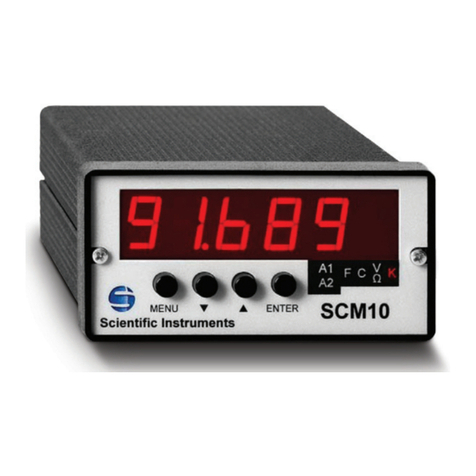
2.3 CALIBRATION PROCEDURES
CAUTION: THE FOLLOWING PROCEDURE IS PERFORMED BY SCIENTIFIC
INSTRUMENTS, INC. AND IS USUALLY ONLY NECESSARY DURING
INITIAL SET-UP OF THE INDICATOR AT THE TIME OF ORDER. IT
HAS BEEN INCLUDED IN THIS MANUAL FOR INFORMATIONAL PURPOSES
ONLY AND IS NOT NECESSARY FOR ROUTINE USE.
By means of the front panel switches, the operator can access the sensor
curve data stored in the internal EPROMs and select a different curve, if
desired. In addition, through the use of a sensor simulator, the operator
can reset an internal reference voltage. The following paragraphs describe
how these functions are accomplished.
2.3.1 Accessing EPROM Sensor Curve Data
CAUTION: SELECTING THE ALTERNATE SENSOR CURVE REQUIRES BOTH CHANGING
THE SENSOR AND ALSO ADDITIONAL HARDWARE CHANGES WITHIN THE
INDICATOR.
a) Before applying power, press and hold both the “up” and
“down” switches. Apply power. After two seconds, release
both switches, then press and hold the “up” switch. After
two seconds, release the “up” switch and then press and
hold it again for two seconds.
b) When the “up” switch is released, the applicable legend
will be displayed to signify which ruthenium oxide c
rve is
being used. The display will flash for two seconds if
neither switch is again pressed.
NOTE: The display will cycle through its programmed
operations (briefly showing reference voltage) until the
legend “CAL” is displayed. At that time, remove power
unless a different curve is to be selected.
c) To select a different curve, press and release either the
“up” or “down” switch while the display is flashing. At
this time, the next sequential legend will be displayed.
Subsequent pressing and releasing of either switch will
cause the instrument to toggle through each curve legend.
When the desired legend is displayed, do not press either
switch; simply wait until the display cycles through its
programmed operations until the legend “CAL” is displayed.
At that time, remove power and the selected curve will be
entered into memory.
WARNING: DO NOT PRESS BOTH SWITCHES WHEN THE “CAL” LEGEND IS
DISPLAYED, OTHERWISE THE INSTRUMENT WILL RECALIBRATE ITSELF AND ITS
TEMPERATURE READINGS WILL NO LONGER BE VALID.
090-226 Rev. D 7



























